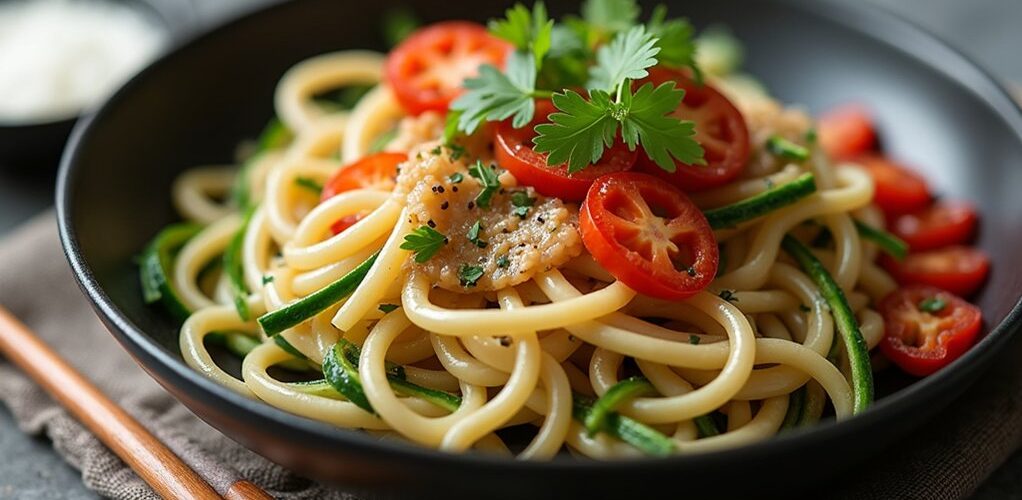
Soba noodles contain moderate carbohydrates, with approximately 21 grams per 100-gram serving, making them a lighter option than traditional wheat pasta but not strictly low-carb. While authentic buckwheat soba offers superior nutritional benefits and a lower glycemic index, many commercial varieties blend wheat flour with buckwheat, increasing carbohydrate content. Careful label reading is essential, as pure buckwheat soba (juwari) contains fewer carbs than wheat-blended alternatives. Understanding the distinctions between different soba varieties reveals important nutritional considerations for informed purchasing decisions.
Key Takeaways
- Soba noodles contain 21 grams of carbohydrates per 100 grams, making them lower in carbs than regular pasta but not truly low-carb.
- Pure buckwheat soba (juwari) has fewer carbs than wheat-blended varieties, but most commercial products combine both flours.
- The glycemic index of 56 makes soba a moderate-carb option that impacts blood sugar less than white rice or udon noodles.
- Check labels carefully, as products without "100% buckwheat" may contain up to 80% wheat flour, significantly increasing carb content.
- For genuine low-carb alternatives, choose shirataki noodles, kelp noodles, or vegetable spirals instead of soba noodles.
The Truth About Soba Noodles' Carbohydrate Content
While soba noodles are often considered a healthier alternative to traditional pasta, their carbohydrate content requires careful consideration for those monitoring their carb intake.
With approximately 21 grams of carbohydrates per 100 grams, including 19 grams of net carbs, soba noodles may not align with low-carb dietary goals.
Even authentic buckwheat soba noodles, which offer superior nutritional benefits compared to regular pasta, contain considerable carbohydrates that could challenge strict low-carb diets.
Many commercial varieties blend buckwheat with wheat flour, potentially increasing the carbohydrate content further.
For those following carb-restricted eating plans, it's essential to check the label carefully, as carbohydrate levels can vary greatly between brands and product types.
Understanding Buckwheat Vs Traditional Wheat Noodles
A fundamental difference between soba and traditional wheat noodles lies in their core ingredients and nutritional composition. While traditional wheat noodles contain over 70g of carbohydrates per 100g, authentic soba noodles made with buckwheat flour provide a more nutritious alternative with only 21g of carbohydrates per 100g. Key distinctions between soba noodles and traditional wheat noodles include:
- Pure buckwheat soba contains no gluten and offers a lower glycemic index
- Soba provides superior protein quality due to buckwheat's lysine content
- Traditional wheat noodles have considerably higher carbohydrate content
The nutritional benefits of authentic soba noodles extend beyond carbohydrate content, as buckwheat flour delivers essential minerals and higher-quality protein compared to conventional wheat-based alternatives. However, consumers should note that many commercial soba varieties combine buckwheat with wheat flour, affecting their nutritional profile. An important aspect of dietary choices is understanding how genetic factors play a crucial role in determining individual responses to different foods, including soba noodles and their impact on health.
Comparing Soba to Other Asian Noodle Varieties
Among popular Asian noodle varieties, soba noodles stand out with their moderate carbohydrate content of 20g per 100g, positioning them between zero-carb shirataki noodles and high-carb options like udon and traditional wheat pasta.
The distinct texture of soba noodles comes from their buckwheat composition, which creates a firmer bite and shorter cooking time compared to softer wheat-based alternatives like udon or rice noodles.
While traditional soba ingredients focus on buckwheat flour, other Asian noodles vary greatly in their base components, from mung bean starch in glass noodles to rice flour in rice noodles, each contributing to unique nutritional profiles and culinary applications.
Carb Content Versus Competition
In terms of carbohydrate content, soba noodles emerge as a moderate option within the spectrum of Asian noodles, containing approximately 20g of carbohydrates per 100g serving.
When examining their glycemic index of 56, soba noodles demonstrate a gentler impact on blood sugar compared to white rice.
- Traditional udon noodles contain over 70% carbohydrates, making soba a more balanced choice.
- Rice noodles and egg noodles typically exceed 70g of carbs per 100g serving.
- Zero-carb alternatives like shirataki noodles provide an even lower option.
It's worth noting that the carb content can vary between brands, particularly when manufacturers blend buckwheat flour with wheat flour.
Consumers should carefully check product labels to verify they're selecting soba noodles that align with their dietary goals.
Texture and Cooking Differences
Distinguishing themselves through unique physical characteristics, soba noodles offer a distinctly different culinary experience compared to their Asian noodle counterparts. Made from buckwheat, these noodles possess an earthy, nutty flavor profile that sets them apart from the milder taste of rice noodles and other Asian varieties.
The cooking process for soba noodles demonstrates notable differences, requiring only 5-7 minutes to reach ideal texture, compared to longer cooking times for alternatives like udon.
Unlike rice noodles, which can become mushy, soba noodles maintain their characteristic firmness and shape when properly prepared. Their slightly chewy texture makes them versatile for both hot and cold dishes, though they require a unique preparation step of cold water rinsing to remove excess starch and halt the cooking process.
Traditional Ingredients Breakdown
The fundamental composition of soba noodles represents a marked departure from other Asian noodle varieties, primarily through its use of nutrient-rich buckwheat flour.
While traditional noodles often rely on high-carb ingredients found in wheat flour, soba noodles contain considerably fewer carbohydrates, typically around 20g carbs per 100g serving.
Key differences in traditional soba composition include:
- Pure buckwheat noodles offer the lowest carbohydrate content and are naturally gluten-free
- Hachiwari varieties blend 80% buckwheat with 20% wheat flour, moderately increasing carb content
- Standard wheat-based Asian noodles contain up to 70% more carbohydrates than traditional soba
This distinct ingredient profile makes buckwheat noodles a superior nutritional choice, offering higher protein quality and essential amino acids compared to conventional wheat-based alternatives.
Blood Sugar Impact and Glycemic Index
Understanding soba noodles' impact on blood sugar levels proves vital for individuals managing their carbohydrate intake. With a glycemic index of 56, soba noodles offer a more favorable option compared to white rice, helping to maintain steadier blood sugar levels throughout the day.
Soba noodles, with their moderate glycemic index, provide a smarter carbohydrate choice for those seeking better blood sugar control.
The presence of buckwheat as the primary ingredient contributes to improved heart health by reducing total cholesterol and triglycerides.
While soba noodles contain approximately 20g of carbohydrates per 100g serving, their lower glycemic index makes them a suitable choice for blood sugar management when consumed in moderation.
Regular consumption of these noodles may help regulate blood glucose levels more effectively than other carbohydrate-rich alternatives, though portion control remains essential, especially for individuals with diabetes.
Hidden Ingredients to Watch For in Store-Bought Soba
When purchasing store-bought soba noodles, consumers should carefully examine ingredient labels to identify the actual buckwheat content, as many commercial varieties contain significant amounts of refined wheat flour.
The presence of wheat flour not only increases the carbohydrate content but can also make the noodles unsuitable for those with gluten sensitivities or those seeking authentic soba experiences.
Traditional juwari soba, made from 100% buckwheat flour, is less common in stores than wheat-mixed varieties, making it essential to look for clear buckwheat percentage declarations and watch for potentially harmful additives in the ingredient list.
Reading Soba Labels Carefully
Shopping for authentic soba noodles requires careful attention to ingredient labels, as manufacturers often blend different flour types that can greatly impact their nutritional profile.
When examining nutritional labels, consumers should focus on identifying authentic, gluten-free options like "juwari soba," which contains 100% buckwheat flour and fewer carbohydrates.
- Look for the specific buckwheat percentage, with "juwari" (100%) or "hachiwari" (80%) clearly stated
- Check carbohydrate content per 100g, as wheat-blended varieties can contain up to 70g
- Scan for unnecessary additives or preservatives that may diminish health benefits
Understanding these label components helps shoppers make informed decisions about their soba noodle purchases, ensuring they align with dietary goals and nutritional preferences.
Wheat Content Warning Signs
Identifying hidden wheat content in store-bought soba noodles requires vigilant attention to ingredient lists and marketing claims, as manufacturers often incorporate substantial amounts of refined wheat flour without prominent disclosure.
Consumers should be particularly wary of products that don't explicitly state "100% buckwheat" on their labels, as these may contain up to 80% wheat flour, greatly increasing their carbohydrate content.
For those following low-carb diets, this distinction is vital, as wheat-heavy varieties can contain more than 70g of carbs per 100g serving.
Additionally, some manufacturers market products as soba noodles while using minimal buckwheat, fundamentally producing wheat-based pasta.
To guarantee authentic soba noodles, shoppers should scrutinize ingredient lists for wheat flour positioning and avoid products with preservatives or unnecessary additives.
Best Low-Carb Alternatives to Soba Noodles
For those seeking to reduce their carbohydrate intake while still enjoying noodle-based dishes, several excellent alternatives to traditional soba noodles exist in the market today.
When searching for low-carb noodle alternatives, consumers can explore options that offer similar textures and versatility while maintaining nutritional benefits.
- Shirataki noodles, derived from konjac yam, contain virtually zero carbohydrates and calories, making them an ideal substitute.
- Kelp noodles provide a neutral-tasting base that readily absorbs flavors while keeping carbohydrates minimal.
- Spiralized vegetables, particularly courgette "zoodles," offer a fresh, nutritious alternative with markedly fewer carbs.
Additional options include spaghetti squash, which creates natural pasta-like strands when cooked, and bean thread noodles, both providing satisfying alternatives with lower carbohydrate content than traditional soba noodles.
Portion Control and Serving Suggestions
Managing portion sizes of soba noodles presents a critical consideration for individuals monitoring their carbohydrate intake, particularly when incorporating these traditional Japanese noodles into a balanced diet.
To effectively control carbohydrate consumption, serving suggestions include using soba noodles as a side dish rather than the main course, or incorporating them into protein-rich salads. Rinsing the noodles under cold water after cooking can help reduce starch content while maintaining their distinctive texture.
For those following a low-carb eating plan, keeping portions modest is essential, as a standard serving contains approximately 21g of carbohydrates per 100g. Pairing smaller amounts of soba noodles with high-protein ingredients and vegetables creates satisfying meals while managing overall carbohydrate intake, making it possible to enjoy these noodles within a controlled dietary framework.
Making Smart Choices for Different Dietary Needs
Different dietary requirements demand careful consideration when incorporating soba noodles into meal plans. For those following a low-carb lifestyle or managing diabetes, understanding the carbohydrate content and making smart choices becomes essential for maintaining balanced nutrition.
- Choose pure buckwheat soba varieties over wheat-mixed options for lower carbohydrate content.
- Consider portion control strategies, such as mixing soba with vegetables to reduce overall carbohydrate intake.
- Explore alternatives like shirataki noodles when stricter carbohydrate restrictions are necessary.
When making dietary decisions, individuals should evaluate their specific health needs and goals. Those with diabetes may need to monitor blood sugar responses carefully, while people following ketogenic diets might opt for smaller portions or alternatives.
Reading product labels and consulting with healthcare providers can help determine the most appropriate choices for individual circumstances.
Traditional Vs Modern Soba Manufacturing Methods
Traditional soba production begins with stone-grinding buckwheat into flour, a time-honored method that preserves the grain's nutritional integrity and distinct flavor profile.
Master soba craftsmen then mix the flour with water and employ intricate hand-pulling techniques to create perfectly textured noodles, a process requiring years of training to master.
In contrast, modern manufacturing relies on automated equipment for grinding, mixing, and extrusion, allowing for higher production volumes and standardized results, though often incorporating wheat flour for improved machinability.
Ancient Buckwheat Stone Grinding
The ancient art of stone grinding buckwheat for soba noodles represents a time-honored technique that preserves both flavor and nutritional value in ways that modern manufacturing methods cannot replicate.
Traditional stone grinding produces a coarser flour that retains more of buckwheat's natural oils and nutrients, essential for creating authentic soba noodles that are both nutritious and flavorful.
Key characteristics of traditional stone-ground buckwheat soba include:
- Preservation of natural oils and beneficial compounds like rutin
- Coarser texture that maintains buckwheat's nutritional integrity
- Pure composition without modern additives or preservatives
While modern manufacturing often includes wheat flour and additives, the authentic form of soba, known as juwari soba, consists solely of stone-ground buckwheat flour and water, offering maximum nutritional benefits and traditional flavor profiles.
Hand-Pulled Noodle Techniques
Mastering hand-pulled soba noodle techniques requires extensive training, precise movements, and an intimate understanding of buckwheat dough's behavior.
Japanese artisans spend years perfecting these traditional methods, which yield noodles with superior texture and authentic flavor profiles.
Unlike modern manufacturing processes that often incorporate wheat flour and mechanical production, traditional hand-pulled techniques utilize 100% buckwheat flour.
This commitment to authenticity not only preserves cultural heritage but also guarantees peak quality control throughout the production process.
The manual technique allows craftsmen to carefully monitor the noodles' thickness and elasticity, resulting in consistently superior products that maintain their integrity during cooking.
While machine-made alternatives offer cost-effective solutions, they often fall short of matching the distinct characteristics and refined texture that skilled artisans achieve through time-honored hand-pulling methods.
Modern Machine Production Methods
While artisanal soba-making techniques have endured for centuries, modern machine production methods have revolutionized the manufacturing environment of these beloved buckwheat noodles.
The shift from traditional method to automated processes has markedly altered how soba noodles are produced, with notable differences in ingredients and preparation.
Modern manufacturing often deviates from authentic juwari soba by incorporating:
- Refined wheat flour for improved durability
- Preservatives and additives that affect nutritional profile
- Mechanical extrusion instead of hand-kneading
This industrialization has made soba more accessible globally, but it has also led to variations in quality and authenticity.
While machine-made versions typically contain an 80-20 ratio of buckwheat to wheat flour, traditional artisanal producers maintain the pure buckwheat composition that defines classic soba craftsmanship.
Reading Nutrition Labels: What to Look For
Understanding nutrition labels on soba noodle packages requires careful attention to several key factors that can greatly impact dietary choices.
Consumers should first examine the total carbohydrates per 100g, which can vary notably from 19g to over 70g across different brands. The fiber content offers vital information about net carb calculations, while the ingredients list reveals whether the noodles contain pure buckwheat flour or additional wheat flour that increases carbohydrate content.
When evaluating nutritional value, it's important to note whether the information applies to cooked or uncooked noodles, as cooking can triple the weight and affect serving calculations.
Additionally, checking for preservatives and additives helps guarantee the product aligns with specific dietary requirements and health goals.
Frequently Asked Questions
Are Soba Noodles Good for a Low Carb Diet?
Despite soba noodle nutrition benefits, they're not ideal for low-carb diets due to high carbohydrate content. Health-conscious individuals should consider gluten-free options like shirataki noodles or practice strict portion control for better results.
Can Type 2 Diabetics Eat Soba Noodles?
Type 2 diabetics can consume soba noodles with proper portion control. Their moderate glycemic index and nutritional benefits make them suitable when incorporated mindfully into diabetes meal planning alongside proteins and vegetables.
Which Type of Noodles Have the Least Carbs?
Shirataki noodles contain the lowest carbs at less than 1g per serving, followed by kelp noodles at 1-2g. Zucchini noodles, spaghetti squash, and other vegetable noodles range from 3-7g per serving.
What's Healthier Rice or Soba Noodles?
Nutritional comparison shows soba noodles surpass rice with higher protein, lower glycemic index, and beneficial antioxidants. Despite similar caloric content, soba provides superior fiber benefits regardless of cooking methods and serving sizes.
Conclusion
While traditional soba noodles made primarily from buckwheat offer moderate carbohydrate content and beneficial nutrients, their impact on blood sugar varies based on ingredients and processing methods. Consumers following low-carb diets should carefully examine nutrition labels, watch for wheat flour content, and control portion sizes. Pure buckwheat varieties provide the best option for carb-conscious diners, though they may cost more and require special handling during preparation.
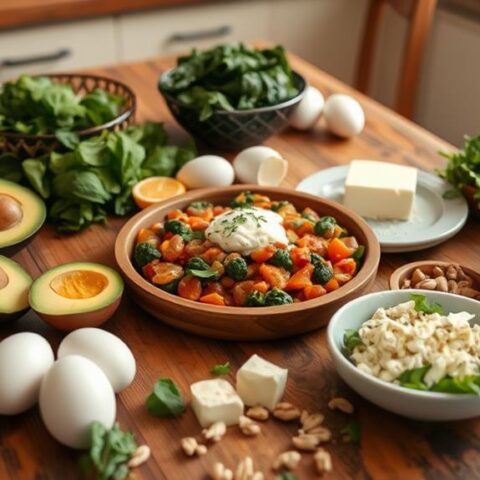



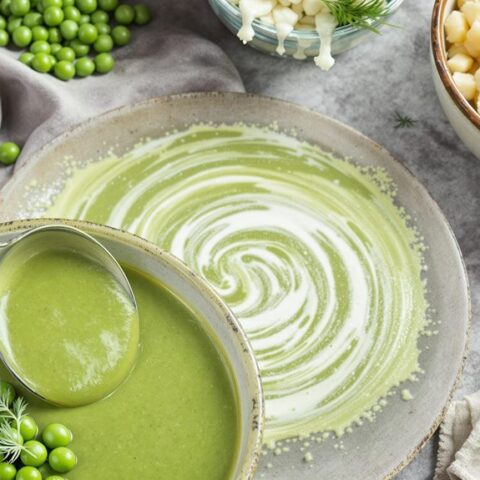
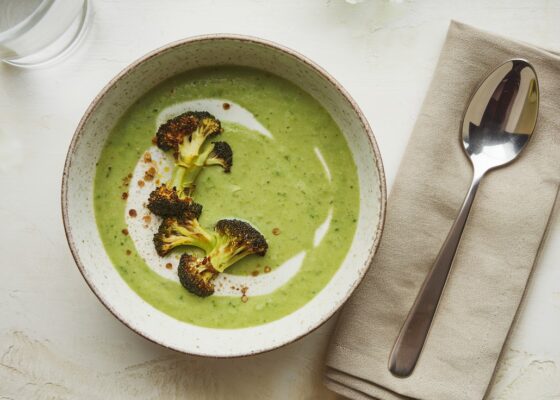

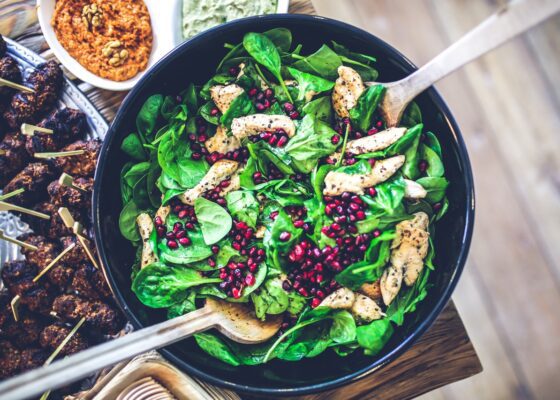

No Comments